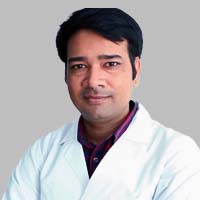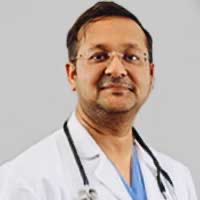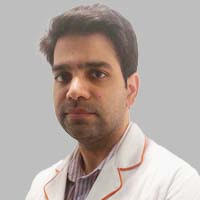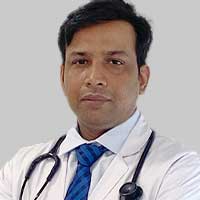All Content Copyright 2025. All Rights Reserved
Connect with Pristyn Care
Book free appointments with minimum wait-time & verified doctor details
Gynaecologist - 24 Yrs. Exp.
Hospital(s): Pristyn Care

General Surgeon - 23 Yrs. Exp.
MBBS, MS - General Surgery
Hospital(s): ![]() Pristyn Care
Pristyn Care
Dr. Pankaj Sareen is an expert and experienced General Surgeon, Laparoscopic Surgeon, Proctologist, and Laser Specialist with an experience of 20 years. He specializes in General, Proctology, Urology, and Laparoscopy. He graduated and obtained his MBBS degree from University College of Medical Sciences & GTB Hospital in 2002, and then his postgraduate MS degree from University College of Medical Sciences & GTB Hospital in 2009.Currently, he is practicing at Pristyn Care Clinic in Delhi. He is fluent in Hindi and English, and provides compassionate care for all his patients to ensure complete recovery. He has been commended by his patients for his caring nature, hard working attitude, and willingness to be there for them - any time of day and night.He provides treatment for the following - Piles, Fissure, Fistula, Abscess, Pilonidal Sinu, and several other conditions. He is registered in the Indian Medical Registry with the license number DMC/R/973. He strives to provide advanced medical care in a comfortable and holistic environment for all patients coming to him for treatment.

Ent Specialist - 20 Yrs. Exp.
MBBS, DLO | Otorhinolaryngologist
Hospital(s): ![]() Pristyn Care
Pristyn Care
Dr. Richa Mina is an expert and experienced ENT Surgeon in Gurgaon over 20 years of experience in treating a wide range of ENT and head & neck conditions. She completed her MBBS from Lady Hardinge Medical College, New Delhi, followed by a Diploma in Otorhinolaryngology (DLO) from Safdarjung Hospital & VMMC, and pursued her DNB (ENT) training at Deen Dayal Upadhyay Hospital, New Delhi. She is currently associated with Pristyn Care, bringing her deep clinical knowledge and skilled surgical care to patients in a compassionate and modern environment. Dr. Richa has worked in reputed institutions including Maharaja Agrasen Hospital (Dwarka), Park Hospital (Gurgaon), and Ruby Hall Clinic. She has held consultant roles at Justice Gopal Charitable Hospital and Lall Nursing Home and served as an ENT specialist under the Ministry of Health, Maldives. Her extensive clinical experience includes managing both inpatient and outpatient ENT services, performing minor and major surgeries, and handling emergency and trauma cases. She has independently performed procedures such as tympanoplasty, septoplasty, tonsillectomy, mastoidectomy, and endoscopic sinus surgeries. Her academic achievements include multiple publications in peer-reviewed journals on ENT epidemiology and surgical techniques.

Gynaecologist - 19 Yrs. Exp.
MBBS, MS-Obs&Gynae
Hospital(s): ![]() Pristyn Care
Pristyn Care
Dr. Surbhi Gupta is an expert and experienced Obstetrician and Gynaecologist with over 12 years of experience in women’s healthcare, high-risk obstetrics, fertility treatment, and laparoscopic gynecological surgeries. She completed her MBBS from the prestigious Maulana Azad Medical College and G.B. Pant Hospital, New Delhi in 2006, followed by her MS in Obstetrics & Gynaecology from Smt. NHL Municipal Medical College, Ahmedabad in 2010. She further achieved the DNB in Obstetrics & Gynaecology from the National Board of Examinations in 2013. Dr. Surbhi is currently associated with Pristyn Care, where she provides comprehensive and personalized care to women across all age groups. Dr. Surbhi has been working consistently to improve women's health outcomes through compassionate clinical care and evidence-based practices. She has gained vast experience managing a wide spectrum of gynecological and obstetric conditions, from prenatal care to complex deliveries, menstrual disorders, fertility challenges, and menopause-related issues. She is also trained in laparoscopic techniques from AIIMS, Delhi, enabling her to perform minimally invasive procedures with faster recovery and better outcomes for her patients. Her dedication to ethical medical practice and personalized patient attention has made her highly trusted among her peers and patients alike.

General Surgeon - 19 Yrs. Exp.
MBBS, MS
Hospital(s): ![]() Pristyn Care
Pristyn Care
Dr. Rakesh Kumar is a General Surgeon, Laparoscopic Surgeon, Vascular Surgeon, Proctologist and a Laser Specialist in Delhi. He completed MBBS from Assam University, Silchar in 2009 and MS from Srimanta Sankaradeva University of Health Sciences Guwahati, Assam in 2014.

General Surgeon - 18 Yrs. Exp.
MBBS, DNB-General Surgery, FMAS, FCLS, FLHS, FICS, FIAGES, MCLS, MNAMS,
Hospital(s): ![]() Pristyn Care
Pristyn Care
Dr. Rahul Poddar is an expert and experienced General Surgeon, Laparoscopic Surgeon, and Colorectal Specialist with over 15 years of experience in General Surgery, Minimal Access Surgery, and Laser Procedures. He earned his MBBS from Vardhman Mahavir Medical College, New Delhi, and his DNB in General Surgery from the same institution. Dr. Poddar holds numerous fellowships, including FMAS, FIAGES, FCLS, FAIS, and FACRSI, reflecting his advanced surgical expertise. He has now joined Pristyn Care, where he continues to provide patient-centered care and advanced surgical solutions. Dr. Poddar’s professional journey includes serving as a Senior Resident in General Surgery at prestigious institutions like Safdarjung Hospital, GTB Hospital, and BL Kapur Super Speciality Hospital in Delhi. He has worked as a Consultant Minimal Access and General Surgeon at Poddar Nursing Home, Ghaziabad, and as an Assistant Professor at Santosh Medical College. His surgical expertise spans laparoscopic cholecystectomy, hernia repair, appendectomy, colorectal surgeries, and advanced laser treatments for conditions like fistula and varicose veins. He has also trained extensively in robotic surgery and laser procedures. Dr. Rahul Poddar is registered with the Uttar Pradesh Medical Council (Registration No: 77776). Known for his dedication and exceptional patient care, he has been recognized for his skills in advanced laparoscopic and colorectal procedures. Fluent in Hindi and English, he strives to provide holistic and compassionate care in a comfortable environment, ensuring the best outcomes for his patients.

Gynaecologist - 17 Yrs. Exp.
MBBS, MS-Obs & Gyne
Hospital(s): ![]() Pristyn Care
Pristyn Care
Dr. Ketaki Tiwari is a well-known Obstetrician and Gynaecologist currently associate with Pristyn Care in Delhi. She has 15 years of experience in Obstetrics and Gynaecology and worked as an expert in different cities in India. She has worked in many reputed hospitals like W Pratiksha Hospital, Falck OPD Clinic, and ESI Hospital in Gurugram. Doctor Ketaki Tiwari has contributed to numerous complex medical cases in several hospitals. She has experience handling 800 deliveries and 300 caesarean sections. She is known for her attention to accurate diagnosis and for treating patients with empathy. The speciality interests of Dr Ketaki are procedures like Hymenoplasty, Vaginoplasty, Labiaplasty, Management of Infertility, Hormonal issues in women, Pregnancy care and Delivery, Abortion (medication, vacuum aspiration, etc), MTP (Medical Termination of Pregnancy), and Period Abnormalities. Dr Ketaki Tiwari did her Graduation from S N Medical College, Agra, in 2008. She also completed Post Graduation from LLRM Medical College, Meerut, in 2013. She has also participated in research work and various workshops under the Obstetrics and Gynaecology department and published many papers.

General Surgeon - 16 Yrs. Exp.
MBBS,MS-General Surgery, FMAS (MUHS), FIAGES
Hospital(s): ![]() Pristyn Care
Pristyn Care
Dr. Piyush Gulabrao Nikam is an expert and experienced General Surgeon, Laparoscopic Surgeon, Proctologist, and Laser Specialist with an experience of 13 years. He specializes in General, Proctology, Urology, and Laparoscopy. He graduated and obtained his MBBS degree from Maharashtra University of Health Sciences, Nashik in 2009, and then his postgraduate MS degree from Maharashtra University of Health Sciences, Nashik in 2013. Currently, he is practicing at Pristyn Care Clinic in Gurgaon. He is fluent in Hindi and English, and provides compassionate care for all his patients to ensure complete recovery. He has been commended by his patients for his caring nature, hard working attitude, and willingness to be there for them - any time of day and night. He provides treatment for the following - Piles, Fissure, Fistula, Abscess, Pilonidal Sinu, and several other conditions. He is registered in the Indian Medical Registry with the license number 91173. He strives to provide advanced medical care in a comfortable and holistic environment for all patients coming to him for treatment.

Aesthetics - 15 Yrs. Exp.
M.B.B.S, M.S. (General Surgery), M.Ch. (Plastic Surgery), DrNB (Plastic Surgery)
Hospital(s): ![]() Pristyn Care
Pristyn Care
Dr. Prateek Thakur is an expert and experienced Aesthetics and Plastic Surgeon with an experience of 8 years, specializing in Aesthetics. He graduated and obtained his MBBS degree from Smt. NHL MMC, Ahmedabad, Gujarat University in 2010, and then his postgraduate MS degree from Pt. BDS, PGIMS, Rohtak, UHS, Haryana in 2015, then earned his M.CH degree from VMMC & Safdarjung Hospital, New Delhi in 2020. Currently, he is practicing at Pristyn Care Clinic in Delhi. He is fluent in English , Hindi and provides compassionate care for all his patients to ensure complete recovery. He has been commended by his patients for his caring nature, hard working attitude, and willingness to be there for them - any time of day and night. He provides treatment for the following - Mole Removal, Gynecomastia, Lipoma, Skin Grafting, Sebaceous Cyst, Hair Reduction, Beard Transplant, Breast Augmentation, Breast Lift, Breast Reduction, Axillary Breast, Breast Lump, Axillary Breast, Breast Augmentation, Breast Cancer, and several other conditions. He is registered in the Indian Medical Registry with the license number DMC/R/7240. He strives to provide advanced medical care in a comfortable and holistic environment for all patients coming to him for treatment.

General Surgeon - 15 Yrs. Exp.
MBBS, MS-General Surgery
Hospital(s): ![]() Pristyn Care
Pristyn Care
Dr. Piyush Sharma is an expert and experienced General Surgeon with an experience of over 14 years. He specializes in general and laparoscopic surgeries, including emergency and trauma procedures, abdominal surgeries, and minimally invasive techniques. Dr. Piyush completed his MBBS in 2010 and his MS in General Surgery in 2013 from Guru Gobind Singh IP University. He has now joined Pristyn Care Clinic, where he provides surgical care using advanced technologies in a patient-friendly environment. During his medical career, Dr. Piyush Sharma served as a Senior Resident in the Department of Surgery at Safdarjung Hospital from 2013 to 2017. His training and work involved handling a wide range of complex surgical cases including bowel resections, nephrectomies, gastrectomies, splenectomies, and Whipple's procedure. He also performed numerous laparoscopic procedures such as cholecystectomies, appendectomies, and hernia repairs (TEP, TAPP). His clinical skills are matched by his academic contributions, with several case reports published in international surgical journals, including studies on splenic artery aneurysms and abdominal wall hernias. He is registered with the Delhi Medical Council under registration number DMC/R/6110. His patients appreciate his commitment, attention to detail, and the reassurance he brings to every case. With his years of clinical and academic experience, Dr. Piyush strives to deliver compassionate, safe, and effective surgical care at Pristyn Care in Delhi
Rhinoplasty is the most common type of nose surgery in [city_name], performed to correct the shape of the nose. Medically, it is called nasal reconstruction, and in common terms, it is called a nose job. Rhinoplasty can be performed for cosmetic and/or reconstructive purposes to improve or restore the form and functions of the nose along with its appearance.
The surgery involves modifying the upper part of the nose, including the bone, cartilage, and skin. In some cases, rhinoplasty is also performed to fix the issues from an injury or birth defect or improve breathing problems. Regardless of the reason why you are undergoing this surgery, it's crucial to understand the procedure, its risks, and its benefits before making the decision.
You should consult a plastic or cosmetic surgeon for nose job surgery in [city_name]. Plastic and cosmetic surgeons are doctors who are well-trained and certified to perform rhinoplasty surgery with safety and precision. However, in certain cases, an otolaryngologist (ENT) doctor can also perform rhinoplasty after gaining ample training and experience.
To find a board-certified surgeon for nose reshaping surgery in [city_name], follow the steps below-
By following these steps, you will be able to make an informed decision after consulting the rhinoplasty surgeon. Always make sure that you feel confident in the surgeon's skills to undergo surgery with his/her hands.
The most common types of rhinoplasty surgery in [city_name] are reduction and augmentation rhinoplasty. However, there are other types as well that address different concerns of the patient.
The most suitable type of rhinoplasty is recommended to the patient after discussing his/her goals and examining the nose.
There are several techniques used in rhinoplasty surgery, depending on the patient's goals and the surgeon's expertise. Two of the most common techniques are:
This technique involves making a small incision on the columella (the tissue between the nostrils) to access the underlying nasal structures. It provides greater visibility and control during the surgery, allowing the surgeon to make more precise modifications to the nose.
This technique involves making incisions inside the nostrils so there is no visible scarring. It's used for more minor modifications and has a quicker recovery time than open rhinoplasty.
Each technique has its own advantages and disadvantages, and your surgeon will work with you to determine the best course of action to deliver the desired outcome.
Rhinoplasty surgery is typically performed on an outpatient basis in a hospital. The steps will be different based on the individual needs of the patients. The general steps involved in the surgery are given below-
The patient will be monitored in a recovery room until the anesthesia wears off. Once the patient regains consciousness, he/she will be discharged after giving a detailed post-op guide and follow-up schedule.